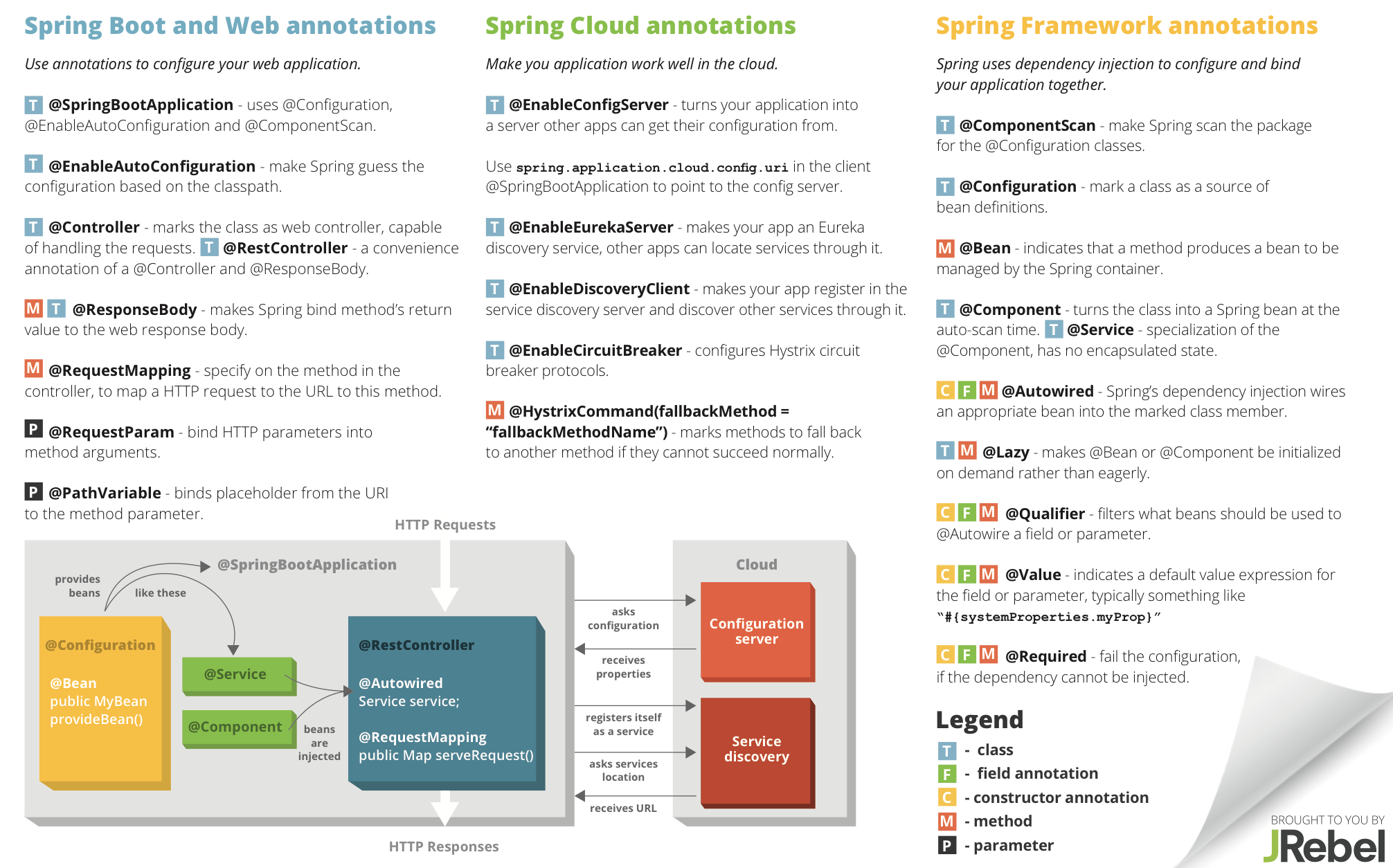Spring - Bean
“A bean is an object that is instantiated, assembled, and otherwise managed by a Spring IoC container. These beans are created with the configuration metadata that you supply to the container, for example, in the form of XML definitions.”
Different types of Spring Beans
- Bean(万金油1,用于method)
- Component(万金油2,用于class)
- Configuration(配置)
- Service(服务)
- Controller(Web App控制层)
- Repository(DAO层)

Properties
- class
- name
- scope
- constructor-arg
- properties
- autowiring mode
- lazy-inialization mode
- initialization method
- destruction method
Inner Bean
Bean inside bean, object inside object
In the example, PointA is an inner bean of square referencing to zeroPoint.
PointB is an inner bean defined inside square.
e.g. applicationContext.xml
<bean id="square" class="com.chennanni.learnspring.Square">
<property name="pointA" ref="zeroPoint" />
<property name="pointB">
<bean class="com.chennanni.learnspring.Point">
<property name="x" value="1" />
<property name="y" value="1" />
</bean>
</property>
</bean>
<bean id="zeroPoint" class="com.chennanni.learnspring.Point">
<property name="x" value="0" />
<property name="y" value="0" />
</bean>
Bean Scope
Basic
- singleton: a single instance per Spring IoC container (default)
- container creates all beans when it is initialized, and then when an object called getBean(), container hands over the bean to the object
- prototyoe: new bean created with every request of reference
- only when an object ask for the bean, container creates a bean and give it to the object
Web-aware Context
- request: new bean per servlet request
- session: new bean per session
- global-session: new Bean per global HTTP session (portlet context)
Syntax
<bean ... scope="singleton">
...
</bean>
Bean Autowiring
When to use it
to autowire an inner bean
比如说有一个class Person,里面有一个inner class Test,
在做DI的时候,会把Person和Test都配置好,但是怎么把这两者关联起来呢?
这里就需要把Testwire到Person上。
- 具体的实现也有两种方式:Annotation和Configuration,
- 如何进行匹配也有两种方式:byName和byType。
class Person {
int id;
String name;
@Autowired
Test test;
}
Annotation
Autowired on Properties
@Autowired
private Person person;
Autowired on Setter Methods
@Autowired
public void setPerson(Person person){
this.person = person;
}
Autowired on Constructors
@Autowired
public Trip(Person person){
this.person = person;
}
Autowired with (required=false) option
@Autowired(required=false)
if can not perform autowire for a property, set it to default value(null)
Configuration
autowire = “byName”: class variable’ name is the same as the name of bean
<bean ... autowire = "byName">
...
</bean>
autowiring = “byType”: class variables’ type is the same as the type of bean
<bean ... autowire = "byType">
...
</bean>
autowire = “constructor”: similar to byType, but type applies to constructor arguments
Note: in the constructor the bean needs to be initiated
<bean ... autowire = "constructor">
...
</bean>
public class Foo {
private Moo moo;
public Foo(Moo moo) {
this.moo = moo;
}
}
Bean Life Cycle
- Initialization
- Use
- Destruction
we can define what should be done after the bean is initialized/destroied
(Take initialization for example, destruction is just the same.)
Two Steps:
- register a shut down hook in the main app
- write the init method
Register a shut down hook
AbstractApplicationContext context = new ClassPathXmlApplicationContext("Beans.xml");
context.registerShutdownHook();
Write the init method
The first way: implement InitializingBean and overwrite its afterPropertiesSet()
public class ExampleBean implements InitializingBean {
public void afterPropertiesSet() {
// do some initialization work
}
}
The second way(recommeded): specify the init-method attribute in the XML configuratoin file to map it to your own init method
<bean id="exampleBean"
class="examples.ExampleBean" init-method="init"/>
public class ExampleBean {
public void init() {
// do some initialization work
}
}
Steps to Create and Use a Spring Bean
- create a bean class (pojo class)
- register and configue it in
application.xmlor using annotation - get the bean using
applicationContext.getBean(...)orbeanFactory.getBean(...)
